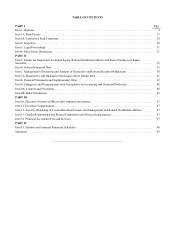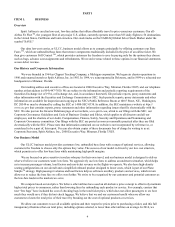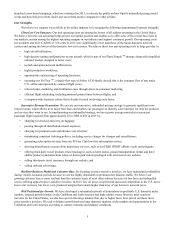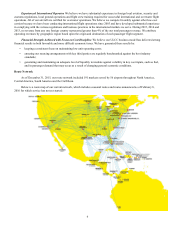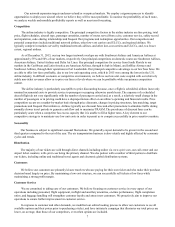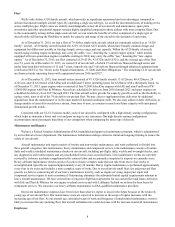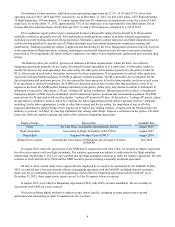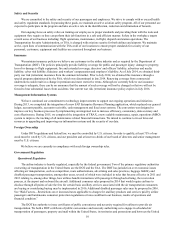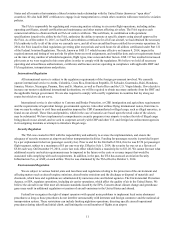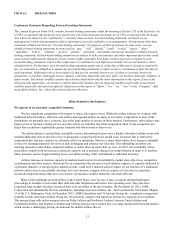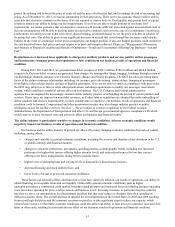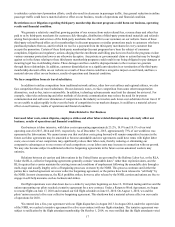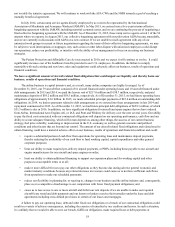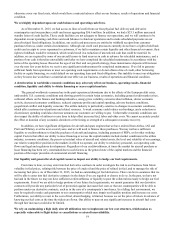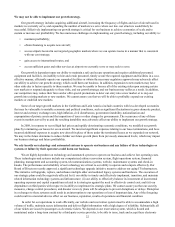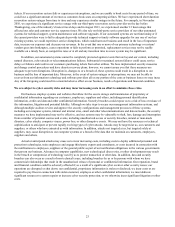Spirit Airlines 2015 Annual Report Download - page 13
Download and view the complete annual report
Please find page 13 of the 2015 Spirit Airlines annual report below. You can navigate through the pages in the report by either clicking on the pages listed below, or by using the keyword search tool below to find specific information within the annual report.13
ITEM 1A. RISK FACTORS
Cautionary Statement Regarding Forward-Looking Statements
This Annual Report on Form 10-K contains forward-looking statements within the meaning of Section 27A of the Securities Act
of 1933, as amended (the Securities Act), and Section 21E of the Securities Exchange Act of 1934, as amended (the Exchange
Act) which are subject to the “safe harbor” created by those sections. Forward-looking statements are based on our
management’s beliefs and assumptions and on information currently available to our management. All statements other than
statements of historical facts are “forward-looking statements” for purposes of these provisions. In some cases, you can
identify forward-looking statements by terms such as “may,” “will,” “should,” “could,” “would,” “expect,” “plan,”
“anticipate,” “believe,” “estimate,” “project,” “predict,” “potential,” and similar expressions intended to identify forward-
looking statements. Such forward-looking statements are subject to risks, uncertainties and other important factors that could
cause actual results and the timing of certain events to differ materially from future results expressed or implied by such
forward-looking statements. Factors that could cause or contribute to such differences include, but are not limited to, those
identified below. Furthermore, such forward-looking statements speak only as of the date of this report. Except as required by
law, we undertake no obligation to update any forward-looking statements to reflect events or circumstances after the date of
such statements. Additional risks or uncertainties (i) that are not currently known to us, (ii) that we currently deem to be
immaterial, or (iii) that could apply to any company, could also materially adversely affect our business, financial condition, or
future results. You should carefully consider the risks described below and the other information in this report. If any of the
following risks materialize, our business could be materially harmed, and our financial condition and results of operations
could be materially and adversely affected. References in this report to “Spirit,” “we,” “us,” “our,” or the “Company” shall
mean Spirit Airlines, Inc., unless the context indicates otherwise.
Risks Related to Our Industry
We operate in an extremely competitive industry.
We face significant competition with respect to routes, fares and services. Within the airline industry, we compete with
traditional network airlines, other low-cost airlines and regional airlines on many of our routes. Competition in most of the
destinations we presently serve is intense, due to the large number of carriers in those markets. Furthermore, other airlines may
begin service or increase existing service on routes where we currently face little competition. Most of our competitors are
larger than us and have significantly greater financial and other resources than we do.
The airline industry is particularly susceptible to price discounting because once a flight is scheduled, airlines incur only
nominal additional costs to provide service to passengers occupying otherwise unsold seats. Increased fare or other price
competition has, and may continue to, adversely affect our operations. Moreover, many other airlines have begun to unbundle
services by charging separately for services such as baggage and advance seat selection. This unbundling and other cost
reducing measures could enable competitor airlines to reduce fares on routes that we serve. In 2015, the availability of low
priced fares coupled with an increase in domestic capacity led to dramatic changes in pricing behavior in many U.S. markets.
Many domestic carriers began matching lower cost airline pricing, either with limited or unlimited inventory.
Airlines increase or decrease capacity in markets based on perceived profitability, market share objectives, competitive
considerations and other reasons. Decisions by our competitors that increase overall industry capacity, or capacity dedicated to
a particular domestic or foreign region, market or route, could have a material adverse impact on our business. If a traditional
network airline were to successfully develop a low-cost structure, compete with us on price or if we were to experience
increased competition from other low-cost carriers, our business could be materially adversely affected.
Many of the traditional network airlines in the United States. have on one or more occasions initiated bankruptcy
proceedings in attempts to restructure their debt and other obligations and reduce their operating costs. They also have
completed large mergers that have increased their scale and share of the travel market. On November 29, 2011, AMR
Corporation and substantially all of its subsidiaries, including American Airlines, Inc., filed a petition for relief under Chapter
11 of the U.S. Bankruptcy Code. In December 2013, AMR Corporation and US Airways Group, Inc. completed a merger and
formally became American Airlines Group Inc. We presently compete with American Airlines in a majority of our markets.
This merger along with earlier mergers between Delta Airlines and Northwest Airlines, between United Airlines and
Continental Airlines, and Southwest Airlines and AirTran Airways, have created four very large and powerful network airlines,
which creates a challenging pricing environment for smaller airlines like us.


